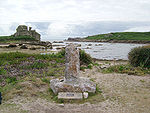St Mary's, Isles of Scilly
| St Mary's Cornish: Ennor | |
 St Mary's poll and harbour | |
|---|---|
| Location | |
| Grid reference: | SV919361 |
| Data | |
| Population: | 1,666 |
St Mary's is the largest island of the Isles of Scilly, a cluster of islands off the westernmost tip of mainland Cornwall. It shares the mild climate and rugged coast for which those islands are known.
St Mary's is the chief port of the islands; the harbour here greets ships from the mainland and its airport received its flights.
Description
The main town is Hugh Town, and is the one part of the islands which is not owned freehold by the Duchy of Cornwall since it was sold to the inhabitants by in 1949. The rest of the island belongs to the Duchy. Other villages on the island are Old Town, Porthloo, Holy Vale, Maypole, Rocky Hill and Telegraph.
The island became the home of British Prime Minister Harold Wilson and his final resting place after his death in 1995.
RNLI
There has been an RNLI lifeboat station on St Mary's since 1837. The first two lifeboats were kept in a boathouse on the town beach at Hugh Town. Following closure in 1855 the lifeboat station was re-opened in 1874 and a boathouse was built on the beach at Porth Cressa. In 1899 a new boathouse and slipway were built at Carn Thomas and the first motor boat arrived in 1919.
The lifeboatmen of St Mary's have saved many lives in the dangerous seas around the islands, and many have been awarded bravery medals for their courage.
Churches
- Church of England:
- St Mary's Church
- St Mary's Old Church
- Methodist: St Mary's Methodist Church
John Wesley preached in Hugh Town on 13 September 1743. The Wesleyan Methodist Society was established in 1788 and the first chapel erected in 1790. This was replaced in 1828. The present Methodist church was built in 1899 by AJ Trenear in Hugh Town. At one time there were three active Methodist chapels on the island and other chapels here and on St Agnes. One now serves as the council chamber for the islands' council.
Sights of the island
Telegraph Tower
The Coastguard's Lookout Tower is also known as the Telegraph Tower. It is used by Radio Scilly for broadcasting. Dating from 1803, it was one of three gun towers built on St Mary's by Major Daniel Lyman. They were intended to accommodate 8-10 men and mount a 32-pounder carronade at the top. It was at this tower about 1898 that Guglielmo Marconi heard wireless signals transmitted from Porthcurno, a distance of 30 miles.
Harry's Walls

Harry's Walls are the remains of an unfinished artillery castle situated on a hilltop to the north-east of Hugh Town. It was begun in 1551 as part of a major phase of fortification on the Isles of Scilly, undertaken to counter threats from the French. It was left unfinished because the site was recognised to be unsuitable.
Giants Castle
Giants Castle is a ruined monument on the coastal path between the airfield and Porthellick Bay.
The Garrison and Star Castle
Star Castle is at the centre of a fortification system around the west side of St Mary’s known as the Garrison. It comprises an outer wall around the outcrop, protecting the town and the castle with strategically placed gun batteries at regular intervals around the outer wall, protecting the castle from all angles. The Castle was built in 1593 by Robert Adams, under the direction of Francis Godolphin, following the Spanish Armada of 1588. Fearing another Spanish invasion, Queen Elizabeth I ordered its construction as a lookout for any intruder ships. The walls of the castle take the shape of an eight-pointed star.[1]
In 1740 Master Gunner Abraham Tovey transformed the Garrison building walls with gun batteries in a circular shape following the coast line of The Hoe. Star Castle is now a hotel.
Peninnis Head
The 46-foot metal tower lighthouse on Peninnis Head was built in 1911 as a replacement for the 1680 lighthouse in the centre of St Agnes. The lighthouse was converted from acetylene gas to electricity in 1992 and the original range of 17 nautical miles was reduced to nine in 2011. [2][3]
Porthellick Cove

Porthellick Cove contains a memorial to mark the spot where the body of Admiral Sir Cloudesley Shovell was washed ashore after the 1707 Scilly naval disaster. This was one of the greatest maritime disasters in British history, when four ships (Association, Firebrand, Romney and Eagle) with nearly 2,000 sailors were lost. Shovell had just 3 years before assisted in the capture of Gibraltar.
Pictures
-
Telegraph Tower
-
Hugh Town
-
St Mary's from an aerial perspective
-
Spanish Windmill
Outside links
| ("Wikimedia Commons" has material about St Mary's, Isles of Scilly) |
References
- ↑ Nikolaus Pevsner (1970) Cornwall; 2nd ed. (The Buildings of England). Penguin; p. 210
- ↑ Changes to lighthouse as it marks 100th year. Cornishman 28 July 2011. p 15.
- ↑ http://www.trinityhouse.co.uk/lighthouses/lighthouse_list/peninnis.html
| Isles of Scilly |
|---|
|
St Mary's •
St Agnes •
Tresco •
Bryher •
St Martin's •
Gugh
|




